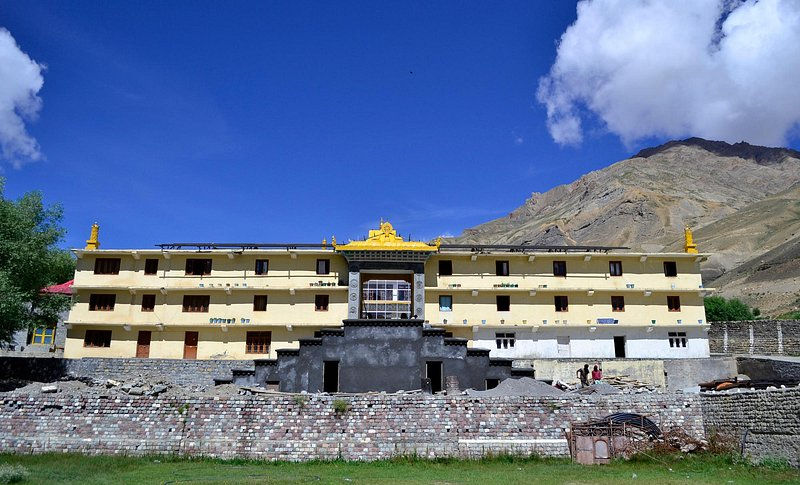Himachal Pradesh Lahaul Spiti: Exploring the Monasteries of Spiti Valley
- arslaankhan987
- Jun 10
- 7 min read
Where Silence Speaks in Stone and Sky
Tucked away in the far reaches of Himachal Pradesh, the Spiti Valley isn't just a destination — it’s a revelation. With prayer flags fluttering in icy wind, mud-brick monasteries clinging to cliffs, and timeless chants echoing through vast canyons, this is where solitude whispers to the soul. Unlike bustling hill stations, Spiti calls out to the wanderer who seeks more than selfies — who longs for stillness, connection, and depth.If you’ve ever wondered what it feels like to stand where the sky meets devotion, the monasteries of Spiti await your footsteps.

Exploring the Monasteries of Spiti: Echoes from the Roof of India
Here are some of the most awe-inspiring monasteries in the valley, each with its own soul, story, and scenery:
1. Key Monastery – The Crown of Spiti
Perched dramatically at 13,668 feet above sea level, Key (or Ki) Monastery is Spiti’s spiritual and visual highlight. This 11th-century fortress-like monastery stands like a watchtower over the valley, housing over 300 monks. Its labyrinthine corridors, prayer rooms, and ancient murals make it a living museum of Tibetan Buddhism. At sunrise, when light hits the whitewashed walls, it feels like the mountains themselves are meditating.

2. Tabo Monastery – The Ajanta of the Himalayas
Founded in 996 AD, Tabo is often called the ‘Ajanta of the Himalayas’ due to its stunning frescoes and wall paintings. It is the oldest continuously operating Buddhist enclave in India. Unlike other monasteries perched on cliffs, Tabo sits quietly on the valley floor — modest in appearance, but majestic in its spiritual and artistic depth.

3. Dhankar Monastery – Hanging Between Earth and Sky
Dhankar means “fort on a cliff,” and this 1,000-year-old monastery does justice to its name. It clings to a narrow ridge overlooking the confluence of the Spiti and Pin Rivers, offering views that will silence even the most talkative traveler. The monastery also shelters ancient scriptures and idols, and is a symbol of resilience, faith, and gravity-defying architecture.

4. Komic Monastery – The Highest in the World
At over 15,000 feet, Komic is the world’s highest motorable village monastery. Snow-covered, isolated, and mystical, Komic feels like a place that exists between worlds. Its monks live a life of simplicity and reflection, and visitors often describe an unexplainable peace here — as if time itself has slowed down.

5. Lhalung Monastery – The Hidden Gem
Often overshadowed by its grander cousins, Lhalung Monastery is one of the oldest in Spiti and is deeply revered by locals. With its quaint mud walls, golden deity statues, and sacred pipal trees, it is believed that the monastery was founded overnight by divine intervention. It is a perfect stop for those who seek quieter, less touristy spiritual corners.

6. Kungri Monastery – The Soul of Pin Valley
Located in the vibrant Pin Valley, Kungri is the second oldest monastery in Spiti and the only one representing the Nyingma school of Tibetan Buddhism. With vibrant prayer flags and festival dances, it brings alive a different hue of Himalayan monastic life — more colorful, more rhythmic, and deeply rooted in tantric practices.

Sample Itinerary: The Sacred Spiral of Spiti (7 Days)
Here’s a sample itinerary to give you an idea of what your trip could look like:
Day 1: Your journey into the heart of Spiti begins as you arrive in Kaza, the district’s peaceful capital surrounded by barren mountains and prayer flags fluttering like secret messages to the skies. After checking into your guesthouse, the day is spent acclimatizing and taking in the calm vibe of the town. A relaxed evening walk through the market, with cups of butter tea and conversations with locals, sets the perfect tone for the spiritual path ahead.
Day 2: The second day takes you on a winding drive to the famous Key Monastery, a thousand-year-old masterpiece perched atop a hill, where monks chant in harmony with the wind. You explore its narrow corridors, ancient prayer halls, and witness monks in silent study. Later, you drive up to Kibber village — one of the highest inhabited villages in the world — where you spend the afternoon experiencing the traditional lifestyle and possibly spotting a Himalayan blue sheep or two.
Day 3: Today, you set out for Dhankar Monastery, dramatically situated on a cliffside above the confluence of the Spiti and Pin Rivers. The monastery offers not just spiritual depth but also panoramic views that are hard to describe in words. After exploring the ancient structure and perhaps even hiking up to Dhankar Lake, the journey continues to Tabo, home to one of the oldest monasteries in the world, where you spend the night soaking in its timeless, peaceful aura.
Day 4: Your morning begins in Tabo, exploring its meditation caves and beautifully painted halls that have survived over a millennium. By midday, you move toward the hidden village of Lhalung, where an underrated yet profoundly sacred monastery awaits. The local legend says this place was blessed by light itself. The day ends with quiet walks through barley fields and glimpses of daily monastic life that feel as though they've remained unchanged for centuries.
Day 5: After a nourishing breakfast, the road rises as you ascend to the mystical village of Komic. Sitting at 15,000 feet, it is home to the world’s highest monastery accessible by road. Here, you feel the thin air and the thick silence, occasionally broken by the sound of spinning prayer wheels or the laughter of young monks. The afternoon is yours to explore the surroundings or simply sit outside the monastery, letting the altitude carry your thoughts away.
Day 6: On the sixth day, you descend into the colorful folds of Pin Valley and visit Kungri Monastery, the region’s only representative of the Nyingma tradition. Known for its vibrant mask dances and ritual energy, Kungri offers a different flavor of faith — one that’s a little louder, a little livelier. You spend time interacting with monks, learning about tantric rituals, and embracing the valley’s raw, untouched beauty before returning to Kaza for the night.
Day 7: The final day is a gentle farewell. You explore local monasteries near Kaza like Sakya Tangyud, reflect on the journey, and collect souvenirs infused with spirit — prayer beads, local crafts, and the kind of inner peace you can’t pack but carry home in your soul. As the road winds back out of the valley, Spiti leaves you not just with memories, but with whispers of solitude that will echo in your heart for a long time.
Fun Activities Along the Way
Yak Safari in Kibber Village – Ride through the rugged Himalayan terrain on a yak, the majestic beast of the highlands. It’s not just a ride, it’s a moment straight out of a mountain fairytale, giving you slow-motion views of Spiti’s surreal landscapes.

Stargazing from Komic or Dhankar – The high-altitude silence, pollution-free skies, and zero light interference turn Spiti into a natural observatory. Lay back under a blanket of stars and let the Milky Way become your nightlight — you might even catch a shooting star whispering secrets from the heavens.

Monk-for-a-Day Experience – Some monasteries like Key or Kungri allow short immersive experiences where you can join morning prayers, learn to spin prayer wheels, or try your hand at Tibetan calligraphy. It's humbling, peaceful, and leaves a mark deeper than any souvenir.

Conclusion: A Journey Beyond Roads and Rituals
As your footsteps fade from the dusted paths of Spiti, what remains isn’t just photographs or souvenirs — it’s the echo of ancient chants, the serenity of silent gompas, and the soulful smiles of monks who have mastered the art of stillness. From the snow-kissed solitude of Komic to the timeless thangkas of Tabo, this wasn’t just a tour. It was a conversation with the cosmos, whispered in winds and painted in prayer flags.
In every monastery, a story awaited. In every valley, a truth unfolded. And somewhere between the bends of barren mountains and the calm of candle-lit prayer rooms, you didn’t just discover Spiti — you discovered something within.
So pack your bag, leave your rush behind,
and walk where the world slows down.
Let the monasteries of Spiti teach you what no city ever could —
how to sit, how to breathe, and how to simply… be. 🕊️
Plan Your Spiritual Escape with Us
At our company, we specialize in crafting journeys that go beyond sightseeing — we design experiences that speak to the soul. Our carefully curated Spiti Monastery Tour is tailored for travelers seeking peace, authenticity, and unforgettable Himalayan beauty. With knowledgeable local guides, comfortable stays, and seamless logistics, we ensure your only job is to be fully present in the moment.
Join us for a journey where silence becomes sacred, and the mountains tell ancient tales.
To know more or book your customized tour, visit us here: Asian Trails India
(FAQs)
What is the best time to visit Spiti Valley for a monastery tour?
The ideal time is from June to September, when the roads are open and the weather is pleasant for travel and exploration.
Is this tour suitable for beginners or first-time travelers to high-altitude regions?
Yes, but travelers should be aware of the high altitude and take time to acclimatize. Our itinerary is designed to ease you in gently.
Do I need any special permits to visit Spiti Valley?
Indian citizens do not need a permit. However, foreign nationals require an Inner Line Permit (ILP), which we can help arrange.
Are the monasteries open to all tourists, including during prayer times?
Most monasteries welcome tourists respectfully, but it’s advised to be quiet and avoid photography during prayer sessions unless permitted.
What kind of accommodation can I expect on this tour?
You'll stay in a mix of local guesthouses, eco-lodges, and homestays, providing both comfort and an authentic cultural experience.
Is the tour customizable for solo travelers or spiritual groups?
Absolutely! We offer flexible plans for solo seekers, couples, families, and spiritual or photography groups.
What should I pack for this trip?
Warm clothes, sunscreen, basic medicines, a good pair of shoes, reusable water bottle, and most importantly — an open heart.











Loved how you broke down the trip day-by-day.
Our Spiti Valley itinerary offers similar day-wise breakdowns, ideal for easy planning